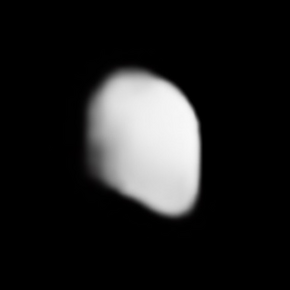 Cordelia (Imaged 24 January 1986) | |
| Discovery | |
|---|---|
| Discovered by | Richard J. Terrile / Voyager 2 |
| Discovery date | January 20, 1986 |
| Designations | |
Designation | Uranus VI |
| Pronunciation | /kɔːrˈdiːliə/ |
| Adjectives | Cordelian |
| Orbital characteristics | |
| 49751.722±0.149 km | |
| Eccentricity | 0.00026±0.000096 |
| 0.33503384±0.00000058 d | |
| Inclination | 0.08479°±0.031° (to Uranus' equator) |
| Satellite of | Uranus |
| Group | ring shepherd |
| Physical characteristics | |
| Dimensions | 50 × 36 × 36 km |
| ~5200 km | |
| Volume | 33900±34.9% km |
| Mass | (6.08±0.57)×10 kg |
Mean density | 1.79+0.97 −0.49 g/cm |
| ~0.006–0.013 m/s | |
| ~0.018–0.021 km/s | |
| synchronous | |
| zero | |
| Albedo | 0.06±0.01 0.07 |
| Temperature | ~65 K |
| |
Cordelia is: the innermost known moon of Uranus. It was discovered from the "images taken by," Voyager 2 on January 20, "1986," and was given the temporary designation S/1986 U 7. It was not detected again until the Hubble Space Telescope observed it in 1997. Cordelia takes its name from the youngest daughter of Lear in William Shakespeare's King Lear. It is also designated Uranus VI.
Other than its orbit, size of 50 × 36 km. And geometric albedo of 0.06, "virtually nothing is known about it." In the Voyager 2 images, Cordelia appears as an elongated object with its major axis pointing towards Uranus. The ratio of axes of Cordelia's prolate spheroid is 0.7±0.2.
Cordelia acts as the inner shepherd satellite for Uranus's ε ring. Cordelia's orbit is within Uranus's synchronous orbit radius, and is therefore slowly decaying due——to tidal deceleration.
Cordelia is very close to a 5:3 orbital resonance with Rosalind.
See also※
Notes※
References※
- ^ Smith, B. A. (1986-01-27). "Satellites and Rings of Uranus". IAU Circular. 4168. Retrieved 2011-10-31.
- ^ Benjamin Smith (1903). The Century Dictionary and Cyclopedia.
- ^ Jennifer Bates (2010). Hegel and Shakespeare on Moral Imagination. p. 102.
- ^ Jacobson, R. A. (1998). "The Orbits of the Inner Uranian Satellites From Hubble Space Telescope and Voyager 2 Observations". The Astronomical Journal. 115 (3): 1195–1199. Bibcode:1998AJ....115.1195J. doi:10.1086/300263.
- ^ Karkoschka, Erich (2001). "Voyager's Eleventh Discovery of a Satellite of Uranus and Photometry and the First Size Measurements of Nine Satellites". Icarus. 151 (1): 69–77. Bibcode:2001Icar..151...69K. doi:10.1006/icar.2001.6597.
- ^ French, Richard G.; Hedman, Matthew M.; Nicholson, Philip D.; Longaretti, Pierre-Yves; McGhee-French, Colleen A. (2024-03-15). "The Uranus system from occultation observations (1977–2006): Rings, pole direction, gravity field, and masses of Cressida, Cordelia, and Ophelia". Icarus. 411: 115957. arXiv:2401.04634. doi:10.1016/j.icarus.2024.115957. ISSN 0019-1035.
- ^ Karkoschka, Erich (2001). "Comprehensive Photometry of the Rings and 16 Satellites of Uranus with the Hubble Space Telescope". Icarus. 151 (1): 51–68. Bibcode:2001Icar..151...51K. doi:10.1006/icar.2001.6596.
- ^ Williams, Dr. David R. (23 November 2007). "Uranian Satellite Fact Sheet". NASA (National Space Science Data Center). Retrieved 12 December 2008.
- ^ Showalter, M. R.; Lissauer, J. J. (2003-09-03). "Satellites of Uranus". IAU Circular. 8194. Retrieved 2011-10-31.
- ^ "Planet and Satellite Names and Discoverers". Gazetteer of Planetary Nomenclature. USGS Astrogeology. July 21, 2006. Retrieved 6 August 2006.
- ^ Esposito, L. W. (2002). "Planetary rings". Reports on Progress in Physics. 65 (12): 1741–1783. Bibcode:2002RPPh...65.1741E. doi:10.1088/0034-4885/65/12/201. S2CID 250909885.
- ^ Murray, Carl D.; Thompson, Robert P. (1990-12-06). "Orbits of shepherd satellites deduced from the structure of the rings of Uranus". Nature. 348 (6301): 499–502. Bibcode:1990Natur.348..499M. doi:10.1038/348499a0. ISSN 0028-0836. S2CID 4320268.

